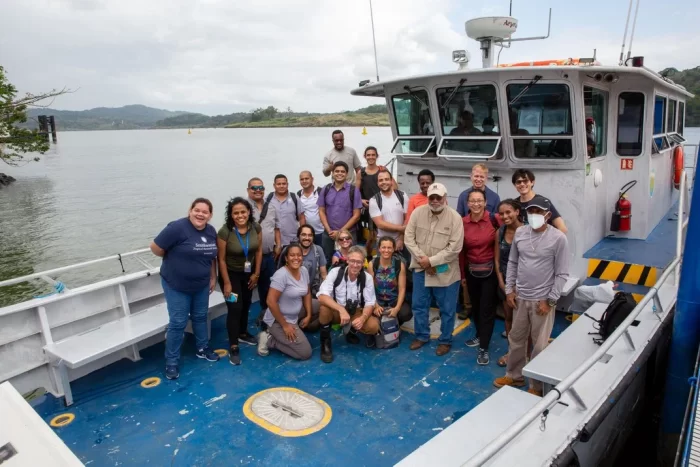A $10 Million Donation Pushes STRI—and the entire Smithsonian—toward a More Sustainable Future
Reflections on STRI’s evolving work, my trip to Panama, and the global reach of local action.
Earlier this month, the Smithsonian received a $10 million donation from philanthropist Adrienne Arsht earmarked for climate resilience research and education efforts. The donation will create the Community-Based Resilience Solutions Initiative, a multi-year endeavor to research tropical resilience and educate the public about climate resiliency more broadly.
To create a center of gravity for the work the Arsht donation makes possible, the Smithsonian Tropical Research Institute (STRI) in Panama will incubate a center for resilience and sustainability. The center will build a research agenda informed by the priorities of those who live in and depend upon complex ecosystems like tropical forests, mangroves, and coastal environments. It will help forge connections among scientists, community members, and policymakers; develop courses for policymakers regarding the integration of rapidly evolving scientific findings into policy decisions; serve as a convening space for multinational teams to design research proposals around sustainability; and develop bilingual educational and outreach tools focused on actionable climate resilience, among other initiatives.

This commitment is a distinct step forward for the Smithsonian initiative Our Shared Future: Life on a Sustainable Planet, which engages all elements of the Institution in increasing our reservoir of knowledge around climate resiliency, sharing that knowledge with the public, and simultaneously reducing our own carbon footprint. It honors the truly interdisciplinary nature of climate change by refusing to relegate this work to a single research center or museum and by centering environmental justice and accessible education in its mission. There is no issue untouched by climate change: it is our collective responsibility to build toward a sustainable future and to do so in the most equitable and just way possible. This donation will help us do exactly that.

I can think of no better place to host this work than STRI. I had the privilege of traveling to Panama this past April, and I was blown away by the rich beauty and history of the country, the remarkable STRI staff, and their diverse portfolio of both localized and global work.
The resounding impact of STRI crystalized for me in a helicopter ride above the Panama Canal. Hovering above the feat of engineering that sliced through the Americas and transformed global commerce, I was struck by this small country’s outsized global economic and scientific impact. Its rich biodiversity makes the region an ideal setting for STRI. The work there is intimately connected to the local community, ranging from reforestation to sustainable fishing practices to creating paths for whales to avoid ships in the canal. Just as important, its cutting-edge research reaches across the Smithsonian Institution and helps people around the world.


I was impressed to meet with a young, predominantly female staff so deeply engaged in their work. I was taken, too, by the sweeping canopy tour we took in the Parque Natural Metropolitano and by the simple act of planting trees at Agua Salud, where STRI is working in partnership with the Panama Canal Authority and Panama’s Ministry of Environment to reforest the Panama Canal watershed.
That work, known as the Agua Salud Project, is in its 14th year. Foundational to the mission is the idea that reforestation can only be successfully accomplished one landowner or community group at a time; no matter how diligent the scientific research, reforestation projects are destined to fail without careful attention to the impact that replanting has on the livelihoods of the people who live there. Agua Salud offers a road map for reforestation initiatives in Panama and across Latin America—which Arsht’s donation will help scale up—showing how to work in close partnership with (and provide employment opportunities for) indigenous communities who call these forests home.

When several of us visited the site, we had the opportunity to each plant a tree there, too. We shoveled soil just adjacent to what was once the US-controlled Panama Canal Zone: a battleground for Panamanian sovereignty, a gateway to the free market, and a site of immense environmental degradation and biodiversity loss. I was struck by the weight of that history and by the significance of seeding new growth here, in a stretch of the earth that is forever changed by and still recovering from one of the most profound instances of human interruption to the natural world.
It fills me with hope to know that every act—from planting a single tree to launching a 10-million-dollar project on sustainability—our remarkable Smithsonian team is tangibly building a more sustainable and equitable future. This work is far too important to remain confined to any one institution or scientific community, and I applaud STRI’s commitment to sharing their findings with the world. I cannot wait to see what our institution-wide commitment to sustainability will bring in the years ahead, in Panama and across the globe.

Posted: 14 November 2022
-
Categories:
Collaboration , From the Secretary , News & Announcements , Science and Nature , Tropical Research Institute







